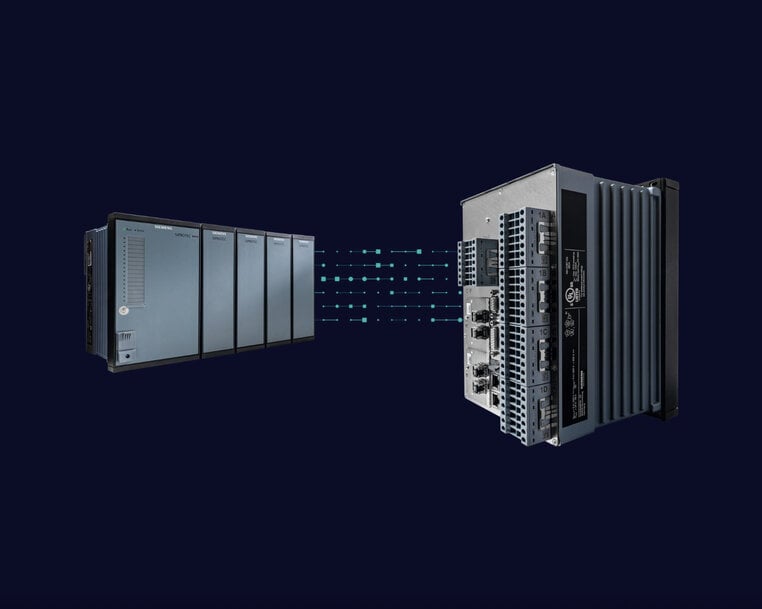www.industry-asia-pacific.com
26
'25
Written on Modified on
Siemens Unveils Seamless PTP Grandmaster Clocks for Digital Substations
New PTP Grandmaster Clocks ensure uninterrupted protection during switchovers with patent-pending seamless changeover, IEEE 1588v2 compliance, enhanced cybersecurity, and resilience without GNSS dependence.
www.siemens.com

Process bus solution Siprotec 5 with Grandmaster Clock: The merging unit digitizes the measured values of the instrument transformers and transmits them as a sampled values data stream via Ethernet to the Siprotec 5 protection devices.
Siemens has unveiled its latest innovation for energy infrastructure: the Siprotec 5 Precision Time Protocol (PTP) Grandmaster Clocks (GMC). Built to secure the backbone of modern power grids, this solution ensures resilient, fail-safe time synchronization for digital substations, safeguarding critical protection functions from disruption, shielding against external disturbances, and strengthening cybersecurity to boost overall grid reliability.
In today's digital power grid, precise time synchronization is essential for protection systems. While many applications require globally accurate time signals, sampled values within process bus systems primarily depend on consistent local precision rather than external global sources.
Siemens' solution separates sample synchronization from global time synchronization using specialized internal time sources. The Siprotec 5 devices, equipped with integrated PTP Grandmaster Clocks compliant with IEEE 1588v2/PTP standard, operate independently from external Global Navigation Satellite System (GNSS) signals. Instead, they use internal oscillators as time references for precise synchronization.
A key feature of this approach is Siemens' patent-pending Seamless PTP grandmaster changeover technology, built into Siprotec 5 devices. This ensures that when primary clocks return, they first align with active backup clocks before resuming their role. In doing so, disruptive time base jumps during switchovers are prevented, keeping protection functions continuously available.
The specialized synchronization enables process bus networks in digital switchgears to operate autonomously without external access points, significantly strengthening cybersecurity by isolating the process bus from the station bus network.
Conventional digital substation architectures often rely on redundant GNSS-based grandmaster clocks. However, even with redundancy, they remain vulnerable: disturbances to GNSS signals, whether from natural phenomena like solar storms or intentional interference such as jamming and spoofing, can cause disruptive 'jumps' in the time base. Such disruptions force merging units to resynchronize, temporarily disabling critical protection functions and can lead to unnecessary removal of equipment from service or even cause false tripping events, impacting grid stability and increasing operational costs. Siemens' new solution mitigates these risks, ensuring uninterrupted, secure operation.
"This technology directly addresses one of the most critical vulnerabilities in digital substations," said Onyeche Tifase, Vice President Product Lifecycle Management at Siemens Smart Infrastructure. "By keeping protection functions active through any time source change and shielding process networks from external threats, we are helping customers operate safer, more reliable, and more sustainable power systems."
www.siemens.com
Siemens has unveiled its latest innovation for energy infrastructure: the Siprotec 5 Precision Time Protocol (PTP) Grandmaster Clocks (GMC). Built to secure the backbone of modern power grids, this solution ensures resilient, fail-safe time synchronization for digital substations, safeguarding critical protection functions from disruption, shielding against external disturbances, and strengthening cybersecurity to boost overall grid reliability.
In today's digital power grid, precise time synchronization is essential for protection systems. While many applications require globally accurate time signals, sampled values within process bus systems primarily depend on consistent local precision rather than external global sources.
Siemens' solution separates sample synchronization from global time synchronization using specialized internal time sources. The Siprotec 5 devices, equipped with integrated PTP Grandmaster Clocks compliant with IEEE 1588v2/PTP standard, operate independently from external Global Navigation Satellite System (GNSS) signals. Instead, they use internal oscillators as time references for precise synchronization.
A key feature of this approach is Siemens' patent-pending Seamless PTP grandmaster changeover technology, built into Siprotec 5 devices. This ensures that when primary clocks return, they first align with active backup clocks before resuming their role. In doing so, disruptive time base jumps during switchovers are prevented, keeping protection functions continuously available.
The specialized synchronization enables process bus networks in digital switchgears to operate autonomously without external access points, significantly strengthening cybersecurity by isolating the process bus from the station bus network.
Conventional digital substation architectures often rely on redundant GNSS-based grandmaster clocks. However, even with redundancy, they remain vulnerable: disturbances to GNSS signals, whether from natural phenomena like solar storms or intentional interference such as jamming and spoofing, can cause disruptive 'jumps' in the time base. Such disruptions force merging units to resynchronize, temporarily disabling critical protection functions and can lead to unnecessary removal of equipment from service or even cause false tripping events, impacting grid stability and increasing operational costs. Siemens' new solution mitigates these risks, ensuring uninterrupted, secure operation.
"This technology directly addresses one of the most critical vulnerabilities in digital substations," said Onyeche Tifase, Vice President Product Lifecycle Management at Siemens Smart Infrastructure. "By keeping protection functions active through any time source change and shielding process networks from external threats, we are helping customers operate safer, more reliable, and more sustainable power systems."
www.siemens.com

